You have read about “the good” Islamabad in Part 1 of this post, which, it seemed from the comments, sent some of you reminiscing about the Islamabad that you knew. Well, here is the not-so-good and the ugly side of Islamabad as seen by me and my camera.
In Part 1 of this series on Islamabad, I had said that there were certain things that ‘self-respecting’ Pakistanis won’t do. Riding a bicycle and carrying anything heavier or larger than a briefcase were two of them. I would like to add one more thing to this list: no proud Pakistani would like to be seen stopping or slowing down his/her car at a crosswalk or ‘zebra crossing’ to allow a pedestrian to cross the road peacefully. Even the cars that are turning from a side street would barrel down at the pedestrians forcing them either to run for their lives – literally – or scurry back to safety.
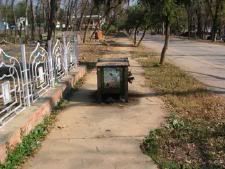
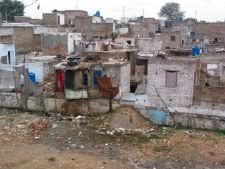
I find it ironic that on the one hand we take so much pride in our cultural values of courtesy, hospitality, lehaaz and “pehlay aap” – and often flaunt them – and on the other hand the moment we get inside a car we toss all those values out, just as we routinely toss candy wrappers and other trash out of our car windows. I have never understood this sudden transformation.
But come to think of it, many of the crosswalks in Islamabad often end up nowhere, anyway –some against a high road divider and others in a ditch. Yes, in a ditch, as can be seen in the pictures here. So, if even you escape the speeding car you may end up tripping over or, worse, in a ditch!
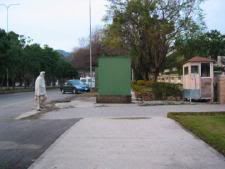
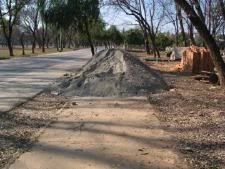
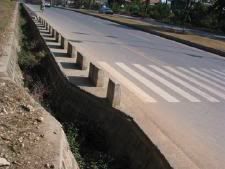
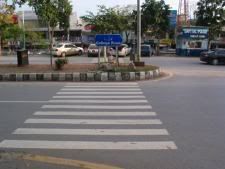
Another thing that would frustrate a newcomer to the town is the lack of adequate and continuous sidewalks. An advertisement supplement on “Destination Pakistan 2007” in last Sunday’s Daily Times boasts:
The master plan of this most modern city was prepared in 1960. Islamabad is one of the few planned cities of the world… It is a modern and a carefully planned city, with tree-lined streets, large houses, elegant public buildings and well organized bazaars.
Yes, it has tree-lined streets and large, in fact very large, houses but this “most modern” and “one of the few planned cities of the world” does not have adequate sidewalks. The sidewalks that are there in the “prestigious” E and F sectors are often blocked by construction material dumped on them and cars parked on them (who said there were no idiots in these sectors?) or, as if this wasn’t bad enough, large transformers installed in the middle of sidewalk by WAPDA. The Greek planners of the city obviously did not factor in Wapda’s ingenuity when planning the city.
It’s a bit ironic that the people, who invented the automobile and manufacture and use it in millions, always build adequate sidewalks for foot traffic in their cities and keep the sidewalks unobstructed both for able bodied as well as for disabled individuals and their motorized or manually pushed chairs. And we, who acquired automobiles relatively recently, totally ignore the need of pedestrians, let alone those of the handicapped.
You cannot see or appreciate a city while driving – or reading about it in newspaper supplements. To take in the sights, sounds and smells of a city you have to be able to walk around without the fear of tripping over, falling in a ditch or being run over. And one finds it very difficult to do that even in Islamabad – “one of the few planned cities of the world”. With all those hurdles placed in one’s way, one has to be a kangaroo to be able to walk around the city. The city planners obviously overlooked something very important and elementary.
Barring the frustration a pedestrian has to go through, Islamabad is mostly a clean city – in fact, very clean by Pakistani or third world standards. Its streets are regularly swept; its drains and sewers rarely overflow; the domestic trash is dutifully picked up from in front of the houses and deposited in the garbage bins and, before the bins start overflowing, they are emptied by garbage trucks.
And who does all this “dirty work”? An army of sanitary staff, men and women, distinguishable by the yellow jackets they wear as their uniform, is employed by the Capital Development Authority (CDA) to keep the city clean. Theirs is one of the most arduous jobs and they provide one of the most essential services a city has to have to survive. Incidentally, Islamabad will not know the difference if all the government offices were closed for a week or so, which they actually are during Eid and Muharram holidays. But if the sanitary workers stop working for a week the city will turn into a garbage dump. Despite that they are the lowest paid and most discriminated of the City employees.
It is very ironic that these workers, who keep the city clean and running, themselves live in squalor in some of the worst slums in most unhygienic conditions – right in the middle of two of the prestigious sectors (F-6 and F-7). Their houses consist of clusters of shanties without adequate drainage or dependable water, power and gas supply. The City has tried to hide these slums from the surrounding localities by building high walls around them, just as one would try to mask a blemish on his/her face. But, is that a solution?
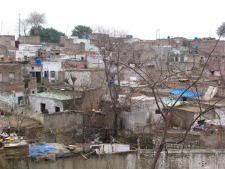
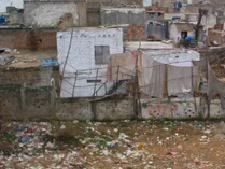
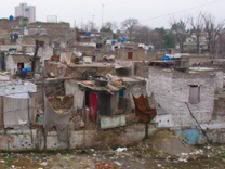
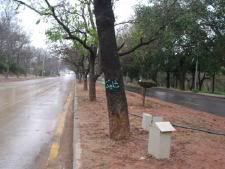
One wonders, why can’t the City, which spends billions of rupees on widening the roads, building public buildings and government housing, playgrounds, parks and expensive monuments (some of them totally wasteful) can’t provide low cost housing to these employees? Something on the lines of Project Housing in New York city or other cities of the world.
Since majority of these workers happen to be Christians they are doubly discriminated. They are excluded from receiving any Zakat money from the government collectively or individually. Private Muslim charities also exclude them for religious reasons. Nor do they even receive sacrificial meat on Eid al-azha.
Very close to the shanties, at a higher level, there is a beautiful, tree-lined, dual carriage road. Nailed to the trees are green metal plates, each bearing one of the attributes of God and the Prophet. Such names and other religious writings were nailed to the trees and lampposts in Islamabad, as in many other cities, in a spate of conspicuous religiosity that hit Pakistan in the last 20 years or so. Included among the sacred names are also al-Rehman (the beneficient), al-Razzaq (the provider) and al-Karaim (the bountiful and generous). I wonder if the people in the shanties who also keep this road clean ever noticed these names and their significance.
Note: Part 1 of this article here. All photographs by author.




















































Sajjad,
[quote]”As for the slum-dwellers, the authorities have attempted to relocate and rehabilitate them in the past, but faced fierce resistance from the same people.”[/quote]
The administration, I believe, wanted to move them to some far flung place outside Islamabad, which would have caused them commuting problems.
Why can’t the CDA build low cost houses right where these shanties are? They are not going to be removed, anyway.
[quote]
“It is prime real estate and they are simply squatting on it.” [/quote]
What about the madrassas that are squatting on some of the most expensive real estate in Islamabad? Why doesn’t the administration move them to the H sector, which is specifically meant for educational institutions? Why a soft corner for one group and total callousness for the other? And, incidentally, sanitary workers are essential for the survival of Islamabad. Madrassas are not.
some of the above comments are a little childish. you do not have to dislike one city in order to like another. is it not possible for BOTH islamabad and karachi to be special in their own ways?
The religosity we impose on ourselves we are now also imposing on trees. Glad that Islamabad’s trees are Muslim!
Thank you for this post. It was very nice and I fully agree with you on most of the issues. However, you have to look at the whole picture. I agree that Isloo isn’t the nicest place for pedestrians, but it isn’t bad either. With the current traffic situation, it is likely better for them than the drivers.
There are places which definitely should have more facilities (such as an overhead bridge/underpass at the dreaded Complex/Citibank crossing), but despite building overhead bridges along the Islamabad highway, I regularly have to avoid hitting pedestrians and bikes attempting to take a short cut on an extremely busy highway. I even had an accident once while dodging one such jaywalker who started dancing in the middle of the highway. It saved his life, but caused damage to both my car as well as a poor taxi driver’s.
As for the slum-dwellers, the authorities have attempted to relocate and rehabilitate them in the past, but faced fierce resistance from the same people. It is prime real estate and they are simply squatting on it. I happen to know some of these people and they make a pretty decent living by working in the elite sectors next door while getting a free and highly sought-after place to live. The issue has to be resolved, but how is this possible if the very people are reluctant to solve it?
As for Eid, it is usually the only occassion when these people show up. When I used to live in the main sectors of Islamabad (roughly 10 years ago), we often threw out our own garbage and cleaned up our own part of the street because these people could only be seen on the holidays. Belonging to a different faith has nothing to do with it and we would still give them whatever we could. With CDA becoming more active recently, things have probaly improved since then.
My comments above may be somewhat cynical, but to solve an issue, one must look at all aspects. We have to change as a society to become truly modern and some of the major issues that we are dealing with can’t be solved simply by generosity, force or will alone.
Arsalan Ali- I do not question people visiting their homes and villages on Eid but I was rather stating the facts.
Going to Faisal Mosque is another part which I do not want to go any further since most of the High Officials pray there and given the current security situation in the country and especially in islamabad where there are a lot of “NO GO” areas established, I don’t think that the attendance would be as much as you could see in the Badshahi Masjid in Lahore or Memon Masjid in Karachi.
Another typical culture of Islamabad and which is now spreading across other cities is that the neighbors would not know who is living next door. I have lived long enough to observe that even if you want to initiate some contact with your neighbors, you get discouraged. Some obvious reasons such as grade and your social status or if you have big expensive cars.
Its not only my observation but I can bet that most people would have observed that when they lived there.
BTW, here is article of Hamid Mir which is also relevant to my point.
http://www.jang.com.pk/jang/feb2007-daily/26-02-20 07/col1.htm